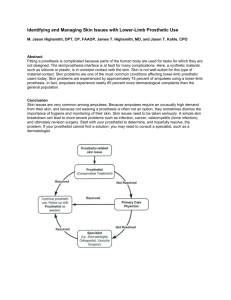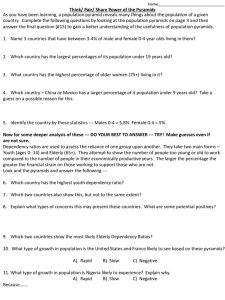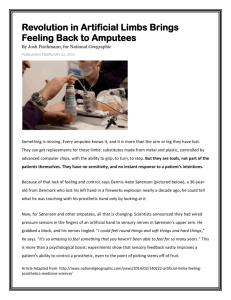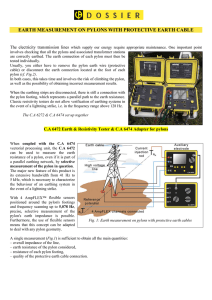Pediatric Extendable Prosthetic Device Cindy Oh, Deema Totah
advertisement
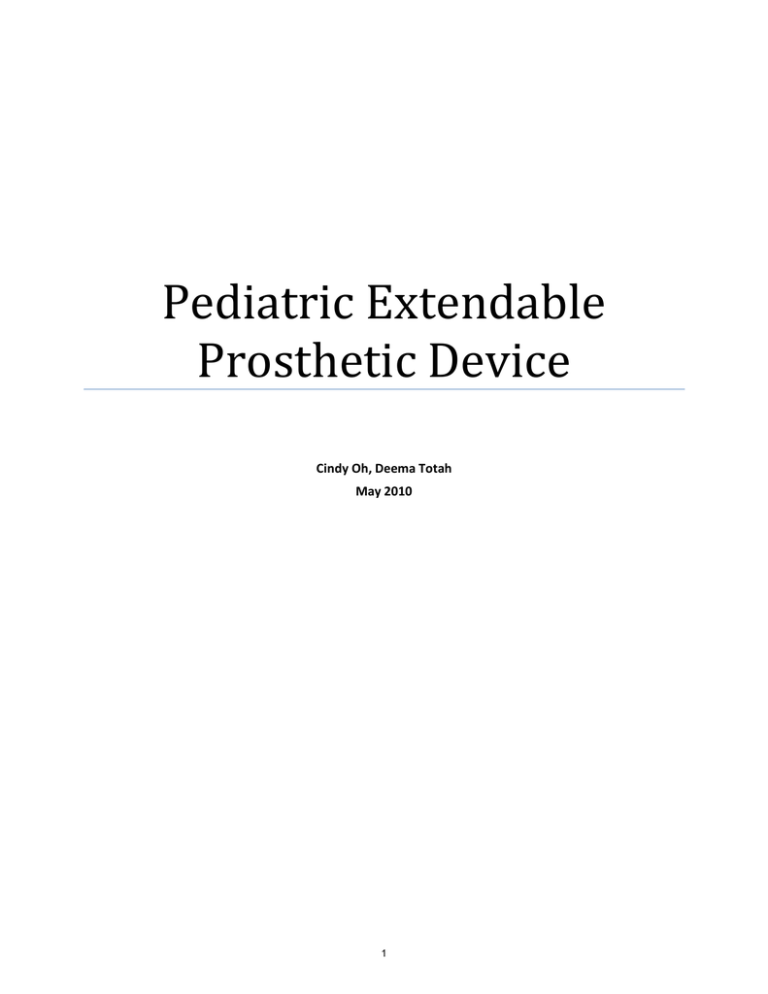
Pediatric Extendable Prosthetic Device Cindy Oh, Deema Totah May 2010 1 Oh, Totah 1 Amputation can happen at any stage in life. As engineers, it’s our job to be able to suit a person’s need, no matter how extreme they may be. The focus of an extendable prosthesis is a growing child. In the states and well-developed countries, there is no such device because frequent trips to the doctor or prostheticist’s office are fairly common. However, in places such as India, amputees cannot afford to spend multiple days getting fitted for their limb, let alone make the trip for multiple return visits. This creates an impasse for young amputees because of their high growth rate. Often times, a child will outgrow his/ her limb within a couple of months, and is in need of a new one. These problems all point to the demand of an extendable child’s prosthetic device. The goals of this project are centered on the user. The leg must be user-modifiable and userfriendly. The child, with the help of the family, must be able to know when and how to adjust the pylon. Additionally, the leg must be robust and stable enough to support the activity of a dynamic child. Of course, there are also requirements for the engineer. These include using a non-toxic, environmental friendly material, keeping the cost low, maintaining the device at a low-weight, and optimizing the strength of the mechanism. All this is done keeping in mind the optimal production methods and materials available at the facility in India. Keeping these restrictions and requirements in mind, a primitive prototype was created. (Figure A) Some other designs we considered are shown in the appendix as well. The rotation-lock mechanism works similarly to many mainstream devices. In the figure shown, there are two coaxial tubes. The inner tube has a knob which slides in the paths restricted by the outer one. By sliding the knob into the horizontal paths the mechanism stays in place. (Figure B) A different mechanism was the binding-clamp ring device. In this case, rings grasp divots on the pylon and restrict movement. (Figure C) The chosen design was the saw-tooth mechanism held together by hose-clamps. The intention behind this device was to create a self-supporting system in which the surface contact between the two 2 Oh, Totah 2 pieces provides a large magnitude of strength. In addition, it is very user-friendly and intuitive, so that the patient/family need minimal training. After working out details such as extension intervals and method of cutting, a 6-inch rod of oil-filled nylon was cut with a water jet into 2 pieces with ridges. The two pieces were then held together by a hose-clamp. (Figure D) The next step in this process was to test different materials and their properties. This was achieved through molding and casting. A template was created, by making a negative mold, and used to efficiently produce multiple pylons of different materials. After various pylons of different plastics were created, a stress test was performed. The maximum stress endured by the Polyurethane pylon was 1300 N/m2. The pylon appeared to fail at the point where the ridges begin from the top – where the stress was applied. This shows that the load on the prosthetic was concentrated at the point where the ridges are free, as was expected. Adding (lego-like) wedges in the empty space between the ridges was proposed as a solution to strengthen the pylon structure. Another crucial aspect of this project was the making of pyramids. (Figure E) The Jaipur system currently doesn’t use a pyramid to align the leg, but instead has a non-adjustable screw. (Figure F) Pyramids will allow for slight adjustments in the XY plane for added comfort for the child as he/ she adjusts and adapts to the prosthesis making it a more personal experience. The original pyramid is made of steel, individually-milled, and extremely expensive. By molding and casting these as well, we were able to maintain the strength of a pyramid, yet reduce the weight by orders of magnitude. Plastic pyramids (3D printed and casted) are shown in the appendix. (Figure G) Finally, as an ongoing project, the most important part is collaboration with young amputees. As team members collaborate with Jaipur Foot, it will soon be discovered if the current device is adequate. If strength or stability becomes a problem, and patients feel insecure in the device, the design will need to be altered to maximize these properties. This can be done by adjusting the mechanics behind the 3 Oh, Totah 3 mechanism. One possible adjustment is rounded teeth so that the force can be dispersed and the risk of cracking can be reduced. This design suggestion might increase sustainability and yield strength. A project is only as successful as the user claims is to be. This project will always have room for improvement, and engineers will always be able to adjust it according to what the amputee may want or need. The extendable pediatric prosthetic device provides so many advantages to a growing child and his/ her family. The hope for the future is that this design may open the door for a wide distribution of a more individualistic product. 4 Oh, Totah 4 Appendix I Figure A Figure B Figure C Figure D 5 Oh, Totah 5 Figure E Figure F Figure G 6 MIT OpenCourseWare http://ocw.mit.edu EC.722 Special Topics at Edgerton Center:Developing World Prosthetics Spring 2010 For information about citing these materials or our Terms of Use, visit: http://ocw.mit.edu/terms.


